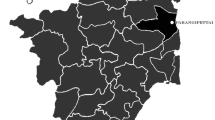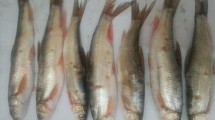Abstract
Rapidly rising temperatures and increasing organic load in the inland and coastal waters has led to a significant increase in parasite population. The isopod Alitropus typus infestation on fish in these waters have become more frequent, causing mortalities in both wild and cultured fishes. The present study was aimed to investigate the infestation on different fish hosts, mean intensity, prevalence, environmental influences on the parasite abundance and the histopathological changes it causes in the host. A total of 219 isopod specimens were collected from 149 infested fishes in two districts of Kerala, India. Among the different fish hosts, Channa striata was found to be the most susceptible, followed by Catla catla, Cyprinus carpio, and Wallago attu, with 81%, 10%, 7%, and 2% occurrence, respectively. The prevalence and mean intensity of infestation were found to be 69.8%, 44.4%, 68.2%, 62.5% and 1.33, 4.25, 1.26, 1.80 in C. striata, W. attu, C. catla, and C. carpio, respectively. The parasite abundance was directly influenced by temperature. The histopathology of affected gill tissues showed epithelial lifting, rupture of secondary gill filaments, vacuole formation and hemocytic infiltration. The findings indicated that the isopod parasite, A. typus had a negative impact on fish health and appearance, causing economic losses to the small scale farmers/fishermen. This is the first reported record of the infestation of isopod parasite, A. typus on the Indian major carp C. catla and C. carpio from India.







Similar content being viewed by others
Data availability
Author declare that there are no objections in the data availability and materials.
References
Achuthan Nair G, Suryanarayanan H, Balakrishnan Nair N (1981) Host specificity and biochemical changes in fishes owing to the infestation of the isopod, Alitropus typus M. Edwards (Crustacea: Flabellifera: Aegidae). Proc Anim Sci 90(4):445–452
Aneesh PT, Sudha K, Helna AK, Anilkumar G (2016b) Mothocya renardi (Bleeker, 1857) (Crustacea: Isopoda: Cymothoidae) parasitising Strongylura leiura (Bleeker) (Belonidae) of the malabar coast of India: redescription, occurrence and life-cycle. Syst Parasitol 93(6):583–599. https://doi.org/10.1007/s11230-016-9646-8
Aydogdu A, Emre N, Emre Y (2015) Prevalence and intensity of parasitic helminths of thicklip grey mullet Chelon labrosus in hosts in beymelek lagoon lake in antalya, Turkey, according to season, host size, age, and sex of the host. Turkish J Zool 39:643–651. https://doi.org/10.3906/zoo-1403-55
Baillie C, Rachel LW, Kerry AH, Nico JS, Stefano M, Robin MDB (2019) Hooked on you: shape of attachment structures in cymothoid isopods reflects parasitic strategy. BMC Evol Biol 19:207. https://doi.org/10.1186/s12862-019-1533-x
Bruce NL (1983) Aegidae (Isopoda: Crustacea) from Australia with descriptions of three new species. J Nat Hist 17:757–788
Bunkley-Williams L, Williams EH Jr, Bashirullah AK (2006) Isopods (Isopoda: Aegidae, Cymothoidae, Gnathiidae) associated with Venezuelan marine fishes (Elasmobranchii, Actinopterygii). Rev de Biol Trop 54:175–188
Carrasson M, Cribb TH (2014) Benign effect of the fish parasitic isopod Ceratothoa cf. imbricata on Selenotoca multifasciata (Scatophagidae) from Australia. Dis Aqua Org 110:173–180. https://doi.org/10.3354/dao02751
Chinabut S (2002) A case study of isopod infestation in tilapia cage culture in Thailand. 201–202. In: Arthur JR, Philllips MJ, Subasinghe RP, reantaso MB, MacRae IH (eds) Primary aquatic animal health care in rural, small-scale, aquaculture development. FAO Fish. Tech. p 406
Collins C, Bresnan E, Brown L, Falconer L, Guilder J, Jones K et al (2020) Impacts of climate change on aquaculture. MCCIP Sci Rev 2020:482–520. https://doi.org/10.14465/2020.arc21.aqu
Ghani NA (2003) Isopod parasites of marine fishes of Pakistan. In: Proceedings of Pakistan congress of zoology 23, pp 217–221
Kirch W (2008) Pearsons correlation coefficient encyclopedia of public health. Springer, Dordrecht. https://doi.org/10.1007/978-1-4020-5614-7-2569
Eiras JC, Castro R, Crustacea. In: Eiras JC, Velloso AL (2016) Pereira Jr J (Ed.). Parasitos de peixes marinhos da América do Sul. Rio Grande: Ed. da FURG. 285–359
Fernado CH, Hanek G (1973) Some parasitic copepod from Sri Lanka (Ceylon) with a synopsis of parasitic crustacea from ceylonese fresh water fishes. Bull Fish Res Stn Sri Lanka (ceylon) 24:63–67
Hanzelova V, Zintan R (1985) Epizootiological importance of the concurrent monogenean invasion in the carp. Helminthologia 22:277–283
Ho J, Tonguthai K (1992) Flabelliferan isopods (Crustacea) parasitic on freshwater fishes of Thailand. Syst Parasitol 21:203–210
Kabata Z (1985) Parasites and diseases of cultured in the tropics. Taylor & francis Ltd., Milton Park
Kensley BF (2001) Guides to the freshwater invertebrates of southen Africa. WTC Report No. TT141/01
Lester RJ, Hayward CJ (2006) Phylum arthropoda. In: Woo PTK (ed) Fish diseases and disorders, 2nd edn. CAB International, London, pp 466–565
Lima FS, Casali GP, Takemoto RM (2013) Crustacea. In: Pavanelli GC, Takemoto RM, Eiras JC (Org.). Parasitologia de peixes de água doce do Brasil. Maringá: Eduem. pp. 371–397
Lopez NC (2001) Parasitic crustaceans in fishes from some Philippine lakes. In: Santiago CB, Cuvin-Aralar ML Basiao ZU (ed.) Conservation and Ecological management of Philippine Lakes in relation to fisheries and aquaculture, pp 75–79
Mallick A, Panigrahi AK (2018) Effect of temperature variation on disease proliferation of common fishes in perspective of climate change. Int J Exp Res Rev 16:40–49
Marcogliese DJ (2008) The impact of climate change on the parasites and infectious disease of aquatic animals. Rev Sci Tech off Int Epiz 27:467–484. https://doi.org/10.20506/rst.27.2.1820
Marcogliese DJ (2016) The distribution and abundance of parasites in aquatic ecosystems in a changing climate: more than just temperature. Integr Comp Biol 56(4):611–9. https://doi.org/10.1093/icb/icw036
Margolis L, Esch GW, Holmes JC, Kuris AM, Schad GA (1982) The use of ecological terms in parasitology (report of an ad hoc Committee of the American Society of Parasitologists). J Parasitol 68:131–133. https://doi.org/10.2307/3281335
Martin JW, Davis GE (2001) An updated classification of the recent Crustacea. Los Angeles: Nat Hist MusLos Angeles County 39:129
Meik JM, Lawing AM (2008) Elevation gradients and lizard assemblage structure in the Bonneville basin, Western USA. J Arid Environ 72:1193–1201
Mishra SS, Choudhary P, Debbarma J, Sahoo SN, Barua A, Giri BS, Swain P, Das R, Das BK, Rathod R, Sahu A, Patil PK (2017) Status of aqua-medicines, drugs and chemicals use in India: a survey report. J Aquac Fisheries 1:004
Montelli L, Lewis J (2008) Survey of biofouling an Australian navy ships: Crustacea; Isopoda and Amphipoda; Caprellidea. Defense science and technology organisation Victoria (Australia) maritime platforms. Div. 1:1
Nair GA, Nair NB (1983) Effect of infestation with the isopod, Alitropus typus M. Edwards (Crustacea: Flabellifera: Aegidae) on the haematological parameters of the host fish, Channa striatus (Bloch). Aquaculture 30:11–19
Nair AG (1980) Biology of the tropical isopods Porcellio laevis Latreille and Alitropus typus M Edwards. Dissertation, University of Kerala. http:/hdl.handle.net/10603/163946
Oommen MA, Shnaker K (2005) Elevarional species richness pattterns emerge from multiple local mechanisms in Himalayan wood plants. Ecology 86:3039–3047
Peninal S, Rathna GS, Elavarasi A, Lalaiselvam M (2014) First report on the recods of parasitic infection in the Moray eel (Thyrsoidea macrura) along the Prangipettai coastal waters (Southeast coaast of India). J Parasit Dis 38:273–276. https://doi.org/10.1007/s12639-012-0227-8
Pillai NK (1954) A preliminary note on the Tanaidacea and Isopoda of travancore. Bull Cent Res Inst Univ Travancore Trivandrum 3:1–22
Rajeena KB, Vineethaa VP, Pillai D (2021) Formulation of an exoskeleton degrading bacterial consortium from seafood processing effluent for the biocontrol of crustacean parasite Alitropus typus. Vet Parasitol 290:109348. https://doi.org/10.1016/j.vetpar.2021.109348
Rajkumar M, Perumal P, Trilles JP (2005a) Cymothoa indica (Crustacea, Isopoda, Cymothoidae) parasitizes the cultured larvae of the Asian sea bass Lates calcalifer under laboratory conditions. Dis Aquat Organ 66:87–90. https://doi.org/10.3354/dao066087
Ravichandran S (2007) Infestation of isopod parasite Lironeca puhi in slender needle fish Strongylura leiura. Res J Parasitol 2:87–93. https://doi.org/10.3923/jp.2007.87.93
Ravichandran S, Rameshkumar G, Kumarave K (2009) Variation in the morphological features of isopod fish parasites. World J Fish Mar Sci 1:137–140
Ravichandran S, Rameshkumar G, Balasubramanian T (2010) Infestation of isopod parasites in commercial marine fishes. J Parasit Dis 34:97–98. https://doi.org/10.1007/s12639-010-0014-3
Ravi V, Rajkumar M (2007) Effect of isopod parasite, Cymothoa indica on gobiid fish, Oxyurichthys microlepis from Parangipettai coastal waters (South-east coast of India). J Environ Biol 28(2):251–256
Roberts RJ (2012) Fish Pathology. Wiley, USA
Santos D, Melo MRS, Mendes DCS, Rocha IK, Silva JPL, Cantanhede SM, Meletti PC (2014) Histological changes in gills of two fish species as indicators of water quality in Jansen lagoon (Sao Luis, Maranhao state, Brazil). Int J Environ Res Public Health 11:12927–12937. https://doi.org/10.3390/ijerph111212927
Shah SAA, Asharf A, Qureshi NA (2017) Morphological characterization and biological control of Alitropus typus (Isopoda:Aegidae). Entomol Res 47(6):352–365. https://doi.org/10.1111/1748-5967.12231
Short EE, Caminade C, Thomas BN (2017) Climate change contribution to the emergence or re-emergence of parasitic diseases. Infect Diseases Res Treat 10:1–7. https://doi.org/10.1177/1178633617732296
Veerapan N, Ravichandran S (2000) Isopod parasites from marine fishes of parangipettai coast. UGC-SAP Monograph Series, Annamalai University, Parangipettai
Wang Y, Wu Z, Wang G, Wang F, Liu Y, LiF HJ (2011) In vivo anthelmintic activity of bruceine A and bruceine D from Brucea javanica against Dactylogyrus intermedius (Monogenean) in goldfish (Carassius auratus). Vet Parasitol 177:127–133. https://doi.org/10.1016/j.vetpar.2010.11.040
Watchariya P, Apiruedee S (2020) New Records of Fish Parasitic Iopods (Crustacea: Isopoda) from the Gulf of Thailand. Animals 10:2298. https://doi.org/10.3390/ani10122298
Acknowledgements
We are grateful to the authorities of Kerala University of Fisheries and Ocean Studies for the facilities extended for carrying out the study.
Funding
This work was supported by grants from the National Surveillance Programme for Aquatic Animal Diseases coordinated by ICAR- NBFGR, Government of India.
Author information
Authors and Affiliations
Contributions
RCG and SG were responsible for data and sample collection, KS and SG were involved with the analysis, results interpretation and drafting of the manuscript. GI in critical revisions and editing of manuscript. As Principal Investigator of the project, DP was responsible for planning of the study, analysis and interpretation of results, critical evaluation and editing of the manuscript.
Corresponding author
Ethics declarations
Conflict of interest
The authors declare that they have no conflict of interest.
Additional information
Publisher's Note
Springer Nature remains neutral with regard to jurisdictional claims in published maps and institutional affiliations.
Rights and permissions
About this article
Cite this article
Suresh, K., Gopi, S., Rakesh, C.G. et al. Occurrence of infestation with the isopod, Alitropus typus M. Edwards (Crustacea: Flabellifera: Aegidae) on commercially important freshwater fishes of Kerala, India. J Parasit Dis 46, 695–703 (2022). https://doi.org/10.1007/s12639-022-01488-0
Received:
Accepted:
Published:
Issue Date:
DOI: https://doi.org/10.1007/s12639-022-01488-0




